Balison Blade with fluttering wings
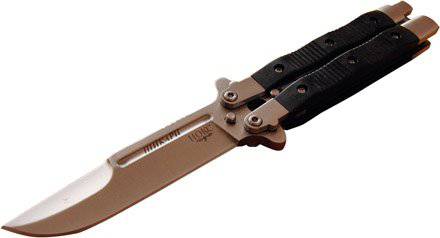
Virtually none of the books devoted to the description of a short blade weapons, not complete without mentioning the balisong. Its popularity is primarily associated with its unique features, which include:
- simplicity and reliability of the design;
- strong fixation of the blade in the open position, practically not inferior to knives with a fixed blade;
- the ability to quickly open and close the knife with one hand (both right and left);
- use of the knife in the closed state as a weapon of self-defense (the technique of working with a short palm stick);
- complete hiding of the blade in the handle in the closed position, which allows the use of double-edged blades.
Many folding knives have some of these properties, but there is hardly another knife with all these capabilities.
History
Despite the wide popularity, the origin of this knife and its Philippine name - “balisong” is still rather vague.
There are two main versions - Filipino and Western.
Philippine version
The word "balisong" (balisong) literally translated from Tagalog (the official language of the Philippines) means "broken horn." The origin of this name is attributed to the fact that for the manufacture of its arms the horns of animals were used (most often water buffalo).
According to the Filipinos, this knife has been known in the Philippines since the eighth century. According to local legends, the balisong was inherited from father to son and was a sacred weapon - in open form, its three ends symbolized three cosmic principles - “Sky”, “Earth” and “Water”. There are many legends about the exploits of warriors armed with balsons. According to one of them, a warrior hit 29 enemies with his balisongs in battle. It is to this legend that the knife is due to the fact that the Spaniards gave him the nickname “Ventii knife” (from Spanish. Ventinueve - twenty-nine).
However, there is no documentary evidence of such an ancient history of Balisong in the Philippines. Only one thing is authentically known - the mass production of these knives was organized by Perfecto de Lyon in the city of Batangas in 1905 (the origin of one of the Philippine knife names, the Batangas knife, is connected with this). Initially, the balisoners were made from iron waste, automobile springs, ball bearing clips or steel files. The standard overall length of the balisong was 29 cm.
By the way, one of the areas of the city of Batangas, where the workshops for the manufacture of these knives are located, is called Balisong. The district gave the name to the knife, or vice versa, the knife - the area is not known for certain.
The production, organized by Perfecto de Lyon, is still supplying classic Filipino knives to the world market.
The oldest balsong knife of Filipino origin, the photo of which exists, was made only in 1910 year.
Most likely in the Philippine legends and tales we are talking about a very different knife. It is unlikely that in the VIII century the ancient Filipinos could have mastered the technology of making balisong in its classic form.
The version that it was a primitive folding knife similar to those made in those times both in Europe and Asia is quite logical.
The technology of making these knives was pretty simple. The animal's horn was sawed off to the desired length, and a longitudinal cut was made in it for the blade. The handle was connected to the blade by a rivet. In the open position, the blade was held by the hand over the shoulder on the shank.
This assumption explains well the origin of the name “broken knife” and corresponds to the religious idea of the three origins of the world - in the half-open position, the knife has three ends, which are formed by the tip of the blade, the handle and the protrusion of the shank.
Due to its low cost and reliable construction, the knife quickly gained popularity in the Philippines and other countries in the region. In addition, the knife fits well with the Eskrima Philippine martial arts system and the Malaysian-Polynesian Kali system.
Western version
According to this version, the knife was imported to the Philippines from Europe or the USA, and its design was taken as the basis of Perfecto de Lyon.
Unlike the Philippine, the Western version has documentary evidence.
In the Middle Ages, the French shipwrights in the construction and repair of ships used a special measuring tool - "pied-de-ru", which received its name from the old French measure of length - "royal foot" (pied-du-rou). In order to compactness it is often made in the form of a folding ruler of the two halves.
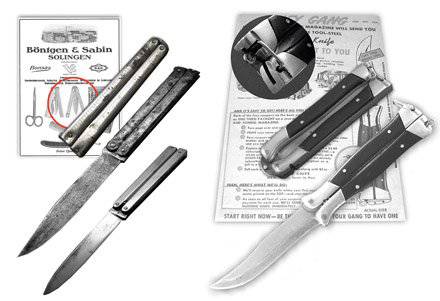
The Museum of the city of Thiers (one of the main centers of knife production in France) keeps the old book “Le Perret”, published in 1710 year. According to this book, at the end of the XVII - the beginning of the XVIII century there existed combined measuring instruments of pied-de-ru, combined with a knife. The book contains the corresponding figure. Samples of these instruments, the oldest of which was manufactured in 1791, have survived to our time. Many experts believe that this is the oldest surviving knife "butterfly".
The first European and American patents for butterfly knives were registered in the late XIX - early XX century. Since there were no spring elements in these knives, they were often called springless knives.
One of the most famous European companies of that time, which produced springless knives, was the Anglo-German company Bontgen and Sabin, which patented its knife version in 1880. Some models of the knives of this company had metric markings on the handles, which makes them similar to the French design de
In the New World, such knives have been known since the beginning of the 20th century. In 1910, Hemming Brothers Cutlery began to produce the Woodsmen model (“forester”), which was positioned as a convenient knife for hiking or fishing.
However, at that time these knives did not receive wide distribution, which was most likely related to the design features - the steel wire latch and its fixation system did not allow opening the knife with one hand.
The growth of the popularity of the balysongs began after the end of the Second World War, when American soldiers began to return from the Pacific theater of combat, carrying them as souvenirs. They also gave the knife the name "click-click" on the characteristic sound made when opening.
In addition, the balisoners came to the United States and with Filipino immigrants. The children of these émigrés added the variety of its names with one more - “Bali Song” (bali-song). For these children, balisong was just as familiar as baseball was for their American peers. Even five-year-olds owned the technique of opening it, although they still did not understand how to use it.
Good performance and low cost have created a demand that has long been met by the import of knives from Southeast Asia.
The peak of the popularity of balisonga in the United States fell on 1970 – 80. due to the growing interest in oriental martial arts.
In 1979, an American, Les De Asis in California, founded the company Pacific cutlery and organized the production of balisong knives. He also registered a trademark consisting of the name “Bali-song” and a butterfly image. It is with this trademark - a butterfly-shaped stigma that is known in the West and in Russia as a butterfly knife.
In 1985, the company was transformed into “Bali-Song Cutlery”, and from 1988, it was named “Benchmade”. In 1990, the company's headquarters was moved from California to Oregon.
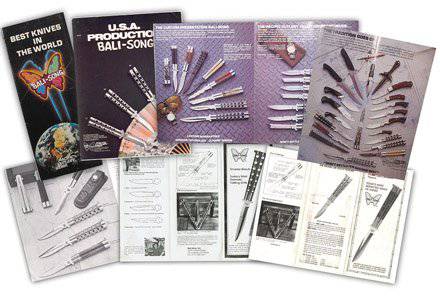
For a long period of time, this company was a trendsetter in the field of the production of knives of this type, and its knives were considered the best. The products of this company was extremely popular among balisong lovers all over the world. Even now, many companies are copying old Pacific cutlery knives.
It was only during the temporary suspension of the release of the Benismade balysongs that the palm of superiority passed to its main competitors, Bear and Jaguar.
In 1970 – 80 on the wave of interest in martial arts, the second coming of the balisongs to Europe takes place.
The spectacular opening of the balisong was actively used in the cinema. And, as a rule, gangsters, street gangs and other “bad guys” were famously acting in the movies. Thanks to the cinema, the image of the knife of criminal elements has become firmly entrenched among ordinary people and officials, and at the beginning of the 1980s. In a number of countries around the world, measures have been taken in law to limit their circulation, carrying and storage.
For example, in the United Kingdom, Switzerland, and Germany, the Balisong knives belong to illegal cold arms, and their wearing and selling are prohibited. In Australia, these knives are cold knives, and special permission is required to carry them. In Canada, in court cases involving the use of a balisong, he is often recognized as an illegal inertial knife. In Hong Kong and the Philippines there are restrictions on the length of the balisong. In different states of the United States there are various restrictions on the circulation, carrying, storage and use of balisongs, up to their complete prohibition.
Recently, in view of the intensification of the fight against terrorism and extremism, in many countries of the world, new restrictions have been adopted concerning these knives.
In this regard, many companies have either restricted or ceased to produce balisongs altogether, and the production center has moved to the countries of Southeast Asia.
On the territory of the Russian Federation, the balisong falls under the restrictions of paragraph 1 of Article 6 of the Federal Weapons Act:
"On the territory of the Russian Federation, it is prohibited to carry cold bladed weapons and knives, the blades and blades of which are either automatically removed from the handle when the button or lever is pressed and fixed by them, or pulled out by gravity or accelerated movement and are automatically fixed when the blade and blade length more xnumx mm. "
Due to these limitations, for a long time only cheap cheap balsongs from China were available on the territory of Russia, the manufacturing quality of which left much to be desired.
Of the quality knives of Benchmade, only the 32 “Mini Morpho” model (8,25 blade length cm) and the 53 “Mangus” model (8 cm) did not fall under these restrictions.
Recently, balysongs made in China have appeared on the Russian market, which are of quite acceptable quality. Thus, Viking Norway supplies to the market more than a dozen models of knives of this type with a blade length from 61 to 87 mm. As the material of the blade in the knife "Viking" is used stainless steel 420.
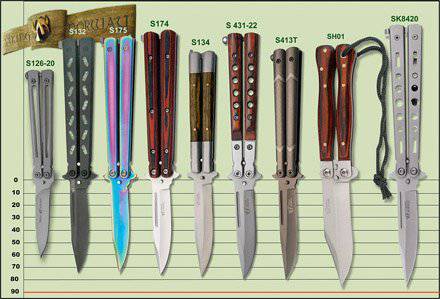
From domestic companies, only the company NOCS produces these knives. In particular, this is the original Shikari model developed by the company's founder Igor Skrylev. With the full length of the knife 19,5 cm, the length of the blade is 8,9 cm. The blade of the knife is quite massive with the thickness of the butt 4,8 – 5,0 mm, has anti-reflective coating and valleys. Blade material - stainless steel 50 x14 MF.
Since the knife "Shikari" was developed as an auxiliary knife of a hunter, there is a liner extractor on its shank.
Design
Balisong belongs to an interesting class of folding knives of the hinged-frame type. All these knives are distinguished by a strong fixation of the blade in the open position and the symmetry of the design, which makes it possible for the knife to control the knife equally well with both the right and left hand.
Classic Balisone Design
In the classic version, the balisong consists of only eight parts: blades, two handles, a latch, a shank pin, three rivets - the axes of the handles and a latch.
When folded, the blade retracts into the groove of the handles and is fixed with a latch. When the knife is opened, the handles turn 180 degrees and clamp the cross pin of the shank between them. Fixing the knife with the latch is due to the elasticity of the material of the handles.
Known master knife fighter Jeff Imada in his guide “The advanced balisong manual” divides the balisongs into large (total length - 28 cm / 12,7 cm), medium (24 / 12,7), small (19 / 8,9) according to the size and length of the blade. ) and ultra small (8,9 / 3,8).
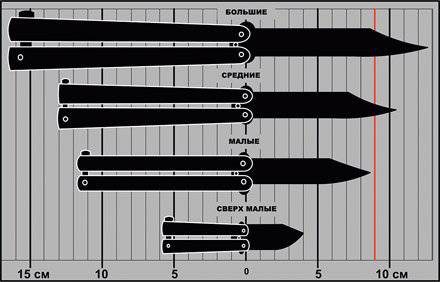
On sale you can also find outlandish souvenir knives - from miniature knives - key rings of only a few centimeters in length to real giants with a nearly two-meter blade.
The design of the balisonga allows you to use almost all forms of the blades of knives and daggers, up to the most exotic.
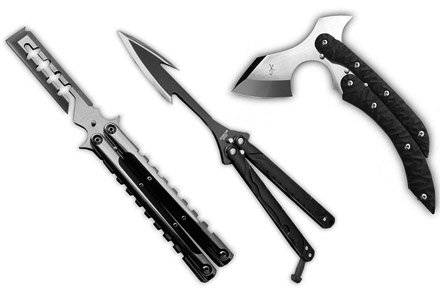
On most modern models of the knife, its shank has small semicircular protrusions - “ears”, which play the role of a kind of guard. In some models, these ears may be absent altogether, while in others they have been transformed into a small guard.
Balisong handles are made of a single piece of metal (a classic construction with a groove - channel constructed) or assembled into a package of several parts (a composite design of the “sandwich” type).
In the Philippines, balisong handles are made of brass, bronze or steel and decorated with decorative inlays of bone, hard wood (camarong, Malay ironwood or nara). In the West, the skeleton form of handles with round or oval holes, which first appeared on Pacific Cutlery knives, has become more widespread.
In modern models of balisongs, spring clips (clips) for carrying a knife in clothing pockets or on a trouser belt are often installed on the arms.
The latch secures the knife in the open or closed state. According to the place of attachment of the latch, Balisongs of the type “Batangas” and “Manila” are distinguished.
Some masters of knife fights generally prefer the balisongs without the locking latch, which makes it possible to reduce the opening time of the knife. However, in this case, for wearing, you must use a leather or plastic sheath.
If a balisong is used as a simple utility knife and is not intended for intensive training in mastering various ways of opening and closing it, such a simple design is sufficiently reliable and durable. It is only necessary to regularly lubricate the hinge elements of the knife.
Advanced Balisone Design
The described classic design of balisong has a number of drawbacks.
Firstly, due to the deformation of the areas of the handles in contact with the pin - retainer, or the pin itself, the latch with time ceases to reliably fix the knife in the closed and open state.
Secondly, with intensive manipulations of the balisong due to friction during the rotational movement of the blade, the gap between the side surface of the blade and the handles increases, as well as the diameter of the swivel holes. As a result of this, a backlash appears and the knife “flares up”.
To prevent deformation of the handles and pin, they increase the area of their contact. This is achieved through special recesses in the arms, increasing the diameter of the pin or by using a flat pin. In addition, a number of knife models use a spring-loaded latch developed by Benchmade in 2001. In this design, a small spring is added to the base of the latch, which reliably fixes the latch head on the handles and prevents the spontaneous disengagement of the handles during operations with a knife.
In the simplest case, the problem of backlash occurring in the axes of the connection of the blade with the handles is solved by using the package design of the handles and replacing the rivets with screws that allow you to “choose” this backlash.
In more advanced models, bronze or teflon bushings and washers are used, which play the role of sliding bearings. The most perfect is the design of a swivel using ball bearings. For the first time the bearing assembly was used in the balisons of the Brazilian company Korh.
The pinnacle of mastery of knife craftsmen-designers are the author’s collection models, which are distinguished by their original design, high quality of workmanship and decoration, and the use of expensive materials. Often for the manufacture of blades used Damascus become, and the blade may have the most unusual forms.
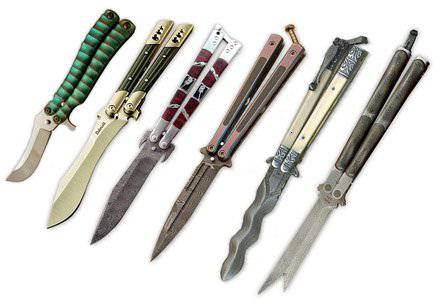
Unconventional designs
In the classic version of the balisong in the closed state, the blade is completely hidden in the slots of the handle. Known knifemaker Chris
Olofson (Chris Olofson) has developed an unusual knife "G1", in which the blade is not completely hidden in the grooves of the handle. The knife was created based on the famous Chinese weapons - "sword of nine rings" guang dao.
The peculiarity of this knife is that the length of the blade is almost twice the length of the handles. When folded, the knife looks like a regular knife-balisong with a blade length of 10 cm. In the opened position, the blade length increases to 23 cm. Thus, this model combines two knives with a short and long blade. Which one to use is chosen by the owner himself based on the nature of the work performed by the knife.
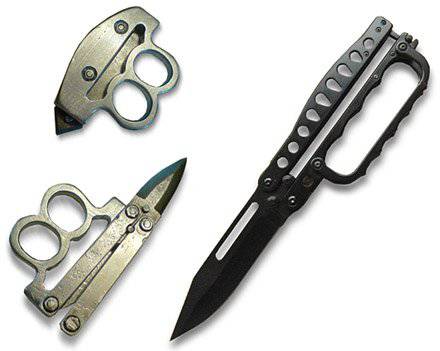
In 2002, the famous knife designer Terry Guinnom developed a prototype of an unusual balisong knife - there was no usual latch in it at all. Fixing the knife was carried out by the so-called "magnetic latch", consisting of magnets embedded in the handle of the knife. Later Guinnom developed a whole series of such knives.
At the beginning of this century, Malay knives "kerambit" (or karambit) with a sickle blade and a ring at the end of the handle became popular on the knife market. The sickle blade provides a ripping effect, and the ring on the handle holds the knife securely in your hand. As a result of symbiosis of kerambit and balisong, a new type of knives appeared, which was called “kerambitsong”.
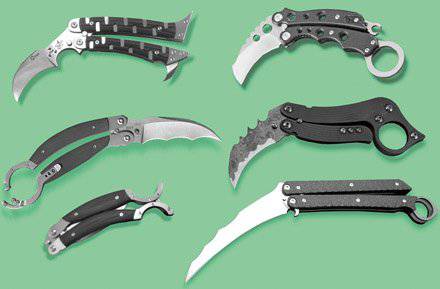
Nowadays, balysongs have also been developed, combining in addition to a knife a whole set of tools for solving a wide variety of everyday tasks. In these knives, the blade is made as a single whole with a steel tool plate, which allows it to be used as a multifunctional tool. For the first time such a balisong - the multitool was developed by the famous Russian designer of knives I. Skrylev.
Initially, this knife was designed as a multifunctional survival tool for Russian astronauts. He was supposed to replace the outdated "Pomegranate" emergency kit, consisting of a folding aviation knife, a machete butt and a pistol for the survival of the TP-82. In addition to the “Werewolf” knife, a pistol for survival “Vepr-1” and a machete “Taiga-2” had to be included in the new set.
The Werewolf knife was first demonstrated at the 1994 Rescue Means exhibition, where it immediately attracted the attention of representatives of the army, the Interior Ministry and special services.
The first five knives "Werewolf" were made by the company "Gallery of copyright weapons." The knife was of high quality workmanship, but was difficult to manufacture. Skrylev finalized the design of the knife, and under the name "Werewolf-2" it was produced by the Tula Arms Plant. The knife was adopted by the special forces of the Ministry of Internal Affairs, and was also used as an army survival knife in some units of the army and special services.
“Werewolf” has no foreign analogues and in its functionality surpasses most of the existing foreign and Russian survival knives.
The main knife blade had a one-and-a-half sharpening, shock teeth on the top of the blade and down to the side surfaces and ensured the possibility of applying effective piercing and splitting blows with either side of the blade. The blade with a length of 11 cm was made of stainless steel 65 x13 (hardness 55 – 57 units on the Rockwell scale) and had a butt thickness of 4 mm. The design of the blade allowed to withstand a fracture load of at least 150 kg. This made it possible to use the knife as a fulcrum when climbing on a vertical surface. To this end, holes were provided in the blade's butt for attaching a climbing carabiner or a safety rope. The tool blade of the knife has saws on wood (up to 12 cm) and metal (up to 20 cm), a device for bending and breaking a wire, a flat-head screwdriver, a small file, a knife for opening cans and a measuring ruler. In addition, the side surface of the knife handles could be used as nippers, pliers, wrenches, as well as for crimping detonators.
Based on the design of the army knife, the company “Saro” (Vorsma) launched the production of the whole family of knives “Werewolf” (the civilian version “Werewolf-2”, “Officer”, “Werewolf-ND”, “Skiff”), which differ in the shape Blade, tool kit, as well as the material used for the manufacture of the blade and tool plate.
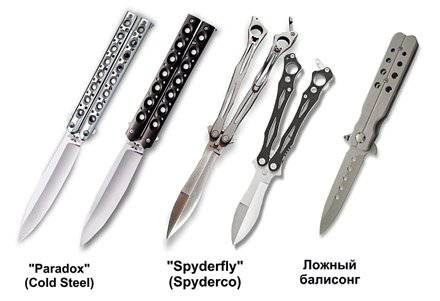
The theme of knives disguised as innocuous household objects, as a rule, a fountain pen, is not bypassed by the designers of balisongs. In 1980's American Terry Gwynn developed a knife in which the handles were of different lengths, while on a longer one of them a clip was installed, similar to the usual clip of pens. During these years, the French master Jean Perret Barilettet designs a balisong, the arms of which are made in the form of fountain pen caps. Subsequently, more complex designs of knives hidden in the body of the fountain pen were created.
Technique of the knife balisong
When used as a weapon of self-defense, this knife combines both blade and impact properties. This allows you to dose the impact on the enemy, depending on the situation, moving from shock and painful techniques with a folded knife to cutting and stabbing blows with an open knife, if necessary.
Shock technique of working with a knife in the folded state does not differ from the work of a short palm-type stick, such as a barrel-muzzle, a yavara or a kubotan. To enhance the impact in some balisongs, special constructive solutions are used: the triangular shape of the shank (Allen Elishewitz's “More” model), the protruding tip of the blade when folded (Fred Perrin's balisong), and the special shape of the knife handles with sharp ends. In this case, the balisong, even when closed, is a very formidable weapon.
In the open state, the technique of working with a balisong does not differ from working with other types of knives, except that only models that can be reliably fixed by a latch can be used for throwing.
For practicing knife fighting in pairs, special training versions of knives are available, significantly reducing the risk of injury during sparring. They are overall copies of real models of balisongs, but their blades have no sharpening, and the tip of the blade is rounded.
To develop the mobility of the fingers, the knife master Eric Meyer has developed a special “Developer of fingers” projectile (KnuckleBuster), which is two metal rods with a hinge joint between them.
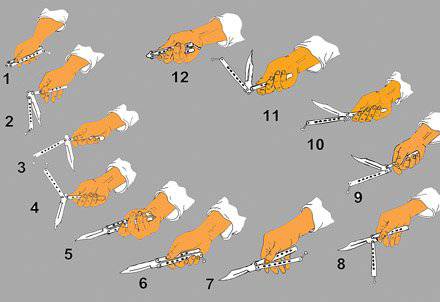
Unlike the technique of working with an open balisong, its very opening and closing differs from ordinary folding knives and can be done in a variety of ways. Recently, such manipulations have become a kind of balisong in a kind of sport and attract more and more enthusiasts. Such tricks with a knife are called "flips" (flipping), or "rotations" (fanning), as well as "rotations in the air" (aerial). Thousands of lovers all over the world enthusiastically master and invent new types of such tricks. The demonstration free performances look very beautiful, in which a series of various manipulations with this knife are demonstrated to the music.
All these beautiful, intricate movements have no practical significance in a real knife fight. Moreover, at the moment of opening the balisong, the fighter is most vulnerable to the enemy knocking the knife out of his hand.
However, the practice of rotations with a balisong perfectly develops the mobility of the fingers and hand, coordination of movements and the “feeling of a knife.”
When mastering manipulations with a balisong, it is necessary to remember that the knife, especially at first, should be held by the “safe” handle in order to avoid cuts of the fingers of the hand. The origin of the name “safe grip” is well explained by photographs of two different knife grips.
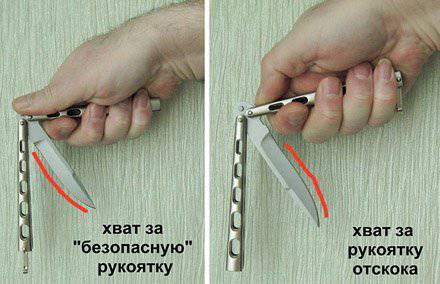
As an example, one of the simplest and most effective methods of opening and closing balisongs is given.
Recently, the popularity of the balisong as a tactical knife has decreased significantly. This is due to two main reasons:
- legal restrictions in many countries around the world that relate to the circulation, carrying and storage of balisongs;
- Improving the design of folding knives, as a result of which the balisongs lost their exclusivity in terms of the possibility of quick opening with one hand, and the modern designs of the blade retainers are almost as good as the balisongs.
Information